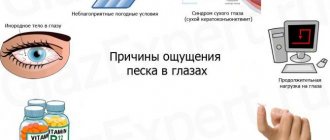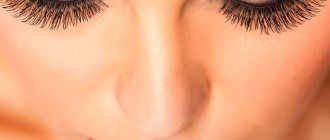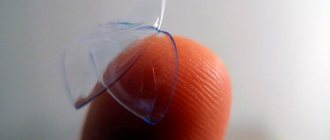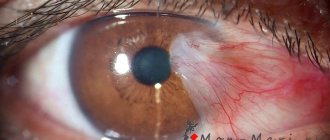The tissues of the visual system are characterized by increased sensitivity. At the slightest contact with a microscopic particle, a person feels discomfort.
Moving your eyelids and squeezing your eyes shut causes severe pain. The problem can be resolved by removing the foreign object.
This is not easy to do, especially if the grain of sand is not visible in the eyeball. We'll tell you in this article how to remove specks from under the upper and lower eyelids.
Signs of a speck getting under the eyelid
A person does not always record the moment a speck hits the eye. Sometimes there is not even an idea of what caused the unpleasant sensations. Some factors indicating the presence of a foreign body are similar to the symptoms of ophthalmological diseases. Therefore, the main guidelines are the following:
- sensation of scratching the tissues of the eye during active blinking;
- irritation of the mucous membrane, redness of the conjunctiva;
- increasing swelling;
- difficulty opening the upper eyelid;
- burning, itching, pain, negative reaction to daylight;
- Decreased quality of vision; a sort of veil interferes with reproducing a clear picture.
The listed manifestations occur against the background of the protective functions of the visual system, which is trying to get rid of a foreign object. The effect is enhanced by the abundant secretion of tear fluid.
How to understand the problem?
If something gets into the eye, itching and discomfort appear, pain is possible, and lacrimation begins. In this way, the protective function of the visual organs is activated, the body tries to get rid of the problem on its own. Severe pain indicates attachment of a foreign body to the cornea or sclera of the eye.
The longer the problem persists, the more difficult it is for a person to fully open the eyelid; the mucous membrane turns red due to blood flow to the capillaries. There is swelling of the eyelid, pain when moving the pupil and trying to open the eye. If you notice any of the above signs, you should immediately consult a doctor.
Preparing for extraction
Before you begin removing the speck, you should prepare everything you need for the procedure. You will need a clean handkerchief or a piece of light-colored fabric. Color in this case is important only for identifying the speck after being caught in a homemade trap.
Cotton swabs and a sterile container with boiled water (or soy solution) may also come in handy. Hands must be washed thoroughly using detergent.
The second stage of preparation is to search for a foreign particle in the eyeball. First, looking in the mirror, slightly move the lower eyelid. Inspection is carried out in any direction between the corners. Then the area behind the upper eyelid is examined in a similar manner. You can also find a speck by opening your eyelids and slowly moving your gaze left and right.
The easiest way to solve the problem is to drive away the speck with tears. At the same time, it is prohibited to close your eyes tightly or rub them with your hands. This can provoke the deepening of a foreign body into the tissue of the visual organ. It will be very difficult to get a grain of sand.
Reference! If you can’t shed a tear, you need to use eye drops that are designed to moisturize. These products are called artificial tears.
Signs of a foreign body getting into the eye and consequences
Any foreign body that gets into the eye immediately causes a number of negative symptoms. Negative sensations are noted immediately after contact with the cornea and depend on where exactly the speck hits. The victim complains about
- sharp pain
- increased lacrimation,
- photophobia and inability to open eyes,
- swelling of the eyelids,
- redness of the sclera of the eyes,
- itching and burning.
Symptoms may persist until the foreign body is removed.
Prolonged irritation of the conjunctiva of the eyes can further lead to complications and cause acute purulent conjunctivitis, as well as
- corneal clouding and cataracts,
- increased intraocular pressure and secondary glaucoma,
- astigmatism,
- vitreous hemorrhage,
- retinal detachment and blindness.
Therefore, the entry of a foreign body into the eye should not be ignored and it is necessary to begin removing it as quickly as possible.
The best ways to remove specks at home
There are many methods for removing grains of sand from the eye. As an example, the most effective methods that do not require special knowledge and skills are given.
By water
If the speck is located on the surface of the mucous membrane, it can be removed with liquid. To do this, boiled water (cooled to room temperature) is poured into a large container. The upper part of the face (eye area) needs to be immersed in water. Make a few leisurely blinks.
An abundant amount of moisture helps the grains of sand to come out. It is worth checking the result in front of a mirror. Having left the area under the eyelids, the speck may get stuck in the corners. If the discomfort has disappeared, the eye rinsing procedure was successful. Extracting a grain of sand with water is considered the most painless way.
Eye drops
If it is not possible to cause excessive tearing, it is recommended to use eye drops. They are prescribed mainly for dry eye syndrome, when the process of tear production is disrupted.
The following ophthalmic solutions can be used as artificial tears:
- Oksial;
- Hyphenation;
- Artificial tear;
- Slesin;
- Natural tear;
- Vidisik.
2-3 drops are injected into each eye. Afterwards, several movements of the eyelids are performed, but very slowly, so as not to damage the eye tissue. Rubbing with hands or a napkin is prohibited. You can turn your pupils around with your eyelids closed. After the manipulations, the eyeball is examined to detect specks. When it reaches a comfortable area, it is removed using the tip of a clean handkerchief (pre-moistened).
Cotton swab
You can also pick up a speck with a cotton swab. You need to act carefully so as not to damage the conjunctiva. After determining the place where the grain of sand is located, the tip of a cotton swab is moistened in boiled water, and the upper or lower eyelid is pulled back with your free hand. All that remains is to remove the foreign body with deft movements.
The procedure ends with washing the eye with antiseptic drops. This will help avoid infection.
If the problem persists
An attempt to remove the hair was unsuccessful: the eyelash hid under the eyelid and was not visible. Sensations of irritation of the mucous membrane and nerve endings will continue. They will be replaced by redness and pain. If a foreign object remains in the eye longer, inflammation may begin, which can lead to irreversible consequences in the tissues of the organ and cause partial or complete loss of vision.
You can add here mechanical damage to the cornea (scratches), which will bother you until it heals and cause the effect of a hair not being removed. You will have to carry out complex treatment with various drugs, antibiotics, which will relieve pain. If left untreated, dangerous eye diseases can develop.
Removing metal debris
When working on machines or other metal processing, chips often get into the eye. This is one of the most dangerous types of mote. A hard, pointed object easily penetrates deep into the tissue. With careless manipulations, the damage area increases, the foreign body hides in the conjunctiva. It is very difficult to detect and extract.
Therefore, doctors do not advise trying to remove the metal speck yourself. It is also prohibited to impact the eyes in any way. Friction or rhythmic blinking causes not only pain, but also further tissue injury.
Reference! You can remove a metal speck on your own only if it is placed on the surface of the mucous membrane. It is recommended to take help from loved ones.
If the shavings are embedded in the tissue of the eyelid or the eyeball, there is no need to take measures to remove them. It is better to go to the clinic as soon as possible. The foreign object is removed there with special tools with a magnet at the tip. Until you arrive at the hospital, it is advisable to keep your eyes open and try not to make rhythmic movements with them. It is prohibited to apply bandages over the injured organ of vision.
Burn symptoms
If you get a burn to the eye, it will be accompanied by quite vivid symptoms: tearing from the affected eye, burning, acute pain. Symptoms of photophobia and decreased visual acuity may occur. There will also be swelling and redness in the eye area. An important aspect of this injury is a burn of the retina; at first, clouding of the cornea is observed, leading to the fact that the tissue begins to die. I also note that there are several degrees of burn:
- Easy. It is marked by swelling of the epithelium, which is also accompanied by swelling of the eyelids. Usually the prognosis is good.
- Average. It manifests itself as clouding of the cornea and the appearance of small bubbles.
- Heavy. Characterized by necrosis of the skin of the eyelids and conjunctiva. A large part of the organ of vision is affected.
- Extremely heavy. Deep necrosis of all tissues occurs. Sometimes perforation of the cornea occurs.
How to remove a speck from another person
You can remove specks from another person's eye using cotton swabs or a clean handkerchief. It is folded so that a loose corner is formed. They use it to pick up a grain of sand and pull it out.
First, the assistant should wash his hands. All items used must also be clean. Next, a search for a foreign body is carried out. To do this, remove the eyelids one by one and ask the victim to slowly make circular movements with the pupils.
If you can’t pick up the speck with a handkerchief or cotton swab, you need to use a saline solution (200 ml of boiled water, ½ tsp of table salt). It is administered using a pipette. A single dose is equal to its volume. The eye is washed with the prepared solution repeatedly. Salt water helps push grains of sand out of the conjunctiva. All that remains is to grab it with a twist from a handkerchief.
The child has
If a speck gets into a child’s eye, you must first examine the affected organ of vision. After identifying its location, extraction is carried out using water, a clean napkin or a cotton swab. Ideally, the grain of sand comes out along with the liquid.
If a foreign body penetrates the conjunctival sac, it is recommended to wash the grain of sand with a small amount of liquid. This is done with a piece of cotton wool. It is moistened in boiled water and lightly squeezed directly into the eye. The jet should be directed into the eye cavity (not at the pupil). A sterile syringe without a needle can be used as a water supply device.
Important! An adult should warn the child against touching the eye with hands or other objects. You need to ask the baby to lie down and completely relax to relieve stress.
If attempts to remove a foreign body do not bring a positive result, it is recommended to urgently consult an ophthalmologist. Prompt medical attention is especially important if metal shavings or glass shards enter the eye. Any manipulation is fraught with serious consequences, so you should not hesitate to go to the clinic.
What types of motes are there?
Specks that get into the eyes are most often:
- fallen eyelash;
- sand;
- midge;
- small pebbles;
- wood shavings.
They usually do not dig into the eyelid due to their structure. As a rule, removing them from the eye is not difficult, even at home.
It is most dangerous when small wood or metal shavings get into the eye and do not come out. This is especially true for metal if it gets into the eye during welding. The heated particle can cause serious damage to the cornea, including loss of vision. The longer the metal is in the eye, the more severe metallosis develops - a reaction between the eye fluid and the trapped speck.
Wood shavings left in the eye can also lead to disastrous consequences. Therefore, if it was not possible to pull it out within the first ten minutes, you should immediately consult a doctor.
In what cases is medical assistance needed?
Of course, you need to try to remove the speck on your own, but experts identify cases when you cannot do without medical help. For example, you should not take any action if the pain increases. Significant changes in eye tissue should also alert you. A trip to the clinic is inevitable if the foreign body cannot be found, but there are all signs of its presence.
An ophthalmologist, using special instruments and equipment, will be able to determine the location of a grain of sand of any size. Microscopic specks are identified using a dye composition.
Cases when you cannot do without medical help:
- the foreign body is not visible, but its presence in the eye is clearly felt;
- redness of eye tissue;
- swelling formation;
- ingress of metal shavings;
- profuse lacrimation, discharge of pus;
- photophobia;
- a sharp drop in visual acuity.
When is medical help needed?
If something gets into your eye and doesn’t come out, you couldn’t remove the speck yourself, and you experience certain symptoms, you need to seek help from a specialist.
This is necessary in the following cases:
- The pain does not go away or gets worse.
- There is a sensation of the presence of a foreign body, despite the fact that it has been removed.
- Inability to detect a speck when the victim is fully confident of its presence.
- After independent attempts, it was not possible to remove the speck, but it is clearly visible.
If the eye is damaged, the patient must urgently call an ambulance or independently take him to the nearest emergency room for assistance. Its types:
- In case of chemical burns, wash the eye with running water, tilting the head down and to the side so that the damaged eye is on top and the water flows freely. The eyelids are spread apart and held with your hand. After the procedure, the eye is covered with a sterile napkin.
- In case of injuries with a blunt object, apply a bandage to the injured eye. An ice pack is placed on top of it to reduce pain. In addition, in case of eye injury, painkillers in the form of eye drops should be used.
- For cut, lacerated and open wounds, a fixing sterile bandage is applied to both eyes. The patient is warned not to blink his healthy eye.
- If a foreign object gets in and a small particle moves freely in the eye, you can remove it using a cloth swab. The foreign body is carefully brought to the corner of the eye at the bridge of the nose and removed.
- If there is a penetrating injury to the eye, it is necessary to urgently try to stop the bleeding. Do not touch the object itself, especially when it has penetrated the eyeball or iris. After that, a bandage of sterile material is applied to the eye.
In all cases, after providing first aid, the patient should be taken to the eye department for examination by an ophthalmologist and appropriate treatment. We must remember that quickly started qualified therapy will avoid many negative consequences.
What to do if the speck won’t come out
If you cannot wash away the speck with water, you can try to remove it with a saline solution. To do this, the liquid is injected into the eye cavity with a pipette. The procedure must be repeated accompanied by slow circular movements with the pupils. If the pain increases, you need to use another washout option. To perform it, take a basin with warm water and immerse the upper part of the face (eye area) in it.
Underwater, with eyes open, make several movements with the pupils. This painless method of washing away debris almost always works. If there is no result, you should contact an ophthalmologist.
The speck becomes more mobile if you pull the upper or lower eyelid with your hands (depending on the location of the grain of sand) and begin to move the pupil in different directions.
There is another way to remove a foreign body. To do this, the eyelid is turned inside out. If a grain of sand is stuck on the internal tissues of the eyelid, a stream from a syringe (without a needle) is directed at it. For open access, use a cotton swab dipped in water.
How to pull it out if it is not visible
If during examination the speck was not detected, but there are symptoms of its presence, you need to rinse the eye with boiled water or use saline solution for the procedure. In this case, any effects on the organ of vision are excluded. When you rub your eyelids or close your eyes, a tiny particle can penetrate the tissue. After this, it will be impossible to remove it yourself.
Another way to identify the location of an invisible speck is to pull back the upper eyelid and hold it in this position. In this case, you need to perform several circular movements with the pupil. This must be done slowly so that the flow of intraocular fluid can push the grain of sand out. If the eye is dry before manipulation, it is recommended to inject eye drops into the conjunctival sac to replace the functions of tears.
Reference! After removing the speck, you should see an ophthalmologist. During the process of removing the foreign body, tissue could be damaged, which requires treatment.
You can detect the speck by everting your eyelid. This opens the conjunctival cavity to maximum visibility. This research should be entrusted to the shoulders of an assistant. In the absence of interference, it is easier to identify the provocateur of discomfort in the eye.
Ways to solve the problem
If it is definitely established that a speck has gotten into your eye, you can try the following methods to remove it:
Symptoms of a corneal burn
- Pull the eyelid over the eyelid. If the speck was small and managed to cause lacrimation, after this procedure it will slip out from under the eyelid by itself.
- If a speck is found, you can make a flagellum out of cotton wool, moisten it in water and carefully touch the speck. It will stick to the flagellum and will be easy to remove. Instead of a cotton wool flagellum, you can use a piece of fabric or a scarf.
- Rinse eye. But this does not mean that you need to open the tap and expose your eyes to the pressure of the stream. The correct way to rinse is to fill a cup or other small container with water, place your open eye in it and blink. The foreign body should come out completely painlessly. If it was not possible to get rid of the speck in this way, you can try another method of washing the eye. To do this, the victim must lie on his side. With clean hands, open the eye slightly, pulling back the upper and lower eyelids. Then water is gently poured onto the eye until the speck is washed away. This method is suitable for young children who find it difficult to explain what needs to be done. But mother should pour water very carefully, preferably from a pipette or a small spoon.
To remove debris, use only fabric or cotton strands soaked in clean water; paper napkins are excluded.
The necessary actions do not end with removing the foreign body from the eye. Most likely the cornea was damaged. To prevent infection and inflammation of scratches, it is recommended to administer antibacterial eye drops. Albucid, Levomycytin or Sulfapyridazine sodium are suitable. Tetracycline ointment is also suitable as an alternative. Under no circumstances should you use hormonal drugs. If a small child is injured, it is important to carefully read the instructions for the drug to see if it is contraindicated at that age.
After the administration of an antibacterial drug, itching, burning, and pain may intensify. This is a natural reaction, because there are wounds on the cornea, it is irritated, you just need to be patient a little. To ensure that the medicine remains where it is needed and does not get into the nasolacrimal duct, after instillation, you should close your eye and gently press your finger on the eyelid in the outer corner for a few seconds.
Sometimes even after removing the debris, it’s as if there is still something left in the eye. This is a sign that the cornea has been damaged. If the injury is minor, the micro-abrasion heals on its own within 24 hours. If after two or three days the eye still stings, it swells, turns red and itches, you cannot hesitate, you need to consult a doctor as soon as possible. But even if everything ended well, you should carefully monitor the condition of the eye and visual acuity for several more days. For any atypical symptoms - pain, photophobia, decreased visual acuity, etc. – You should also consult an ophthalmologist, even if such symptoms occur only from time to time.
Helpful tip: Never use tweezers, scissors or other pointed objects to remove a piece of earth, wood, blade of grass or scale from the eye. A paper napkin is also not suitable: it can leave small fibers that will cause the same discomfort as a speck. But it will be much more difficult to remove them.
Precautionary measures
To prevent eye problems, doctors recommend not taking unnecessary actions when removing a speck. Need to exclude:
- use of sharp objects (needles, toothpicks, etc.);
- use of tweezers;
- rubbing of eye tissues;
- severe squeezing;
- applying compresses.
Eyes should be kept open. The victim is asked to sit down or lie down so that he can relax. Do not try to remove a grain of sand with a dry cloth. This will cause unnecessary problems. In addition, villi will remain on the mucous membrane, which also provoke discomfort.
Important! All items used must be sterile. Otherwise, there is a risk of eye infection.
Washing is the best way to remove a foreign body. But doing it under running water is irresponsible. Usually, such a decision is fraught with the penetration of specks even deeper under the eyelids.
If attempts to get rid of a grain of sand for 5-10 minutes do not lead to anything, there is no need to delay going to the clinic. Further manipulations will harm the health of the eyes.
It is easier to prevent any problem than to eliminate the consequences. Therefore, when processing metal or wood workpieces, you should wear safety glasses. This will prevent the ingress of small particles when sprayed with a tool. Similar precautions must be taken when riding a motorcycle, bicycle, or playing with a ball on the beach.
How to remove an eyelash from an eye
To do this, I recommend preparing the following:
- a clean handkerchief;
- paper napkins;
- artificial tear eye drops;
- a glass;
- mirror.
I offer these step-by-step instructions:
- Wash your hands with antibacterial soap.
- Choose a room in your home with good natural light.
- Perform a visual examination of the eye. Expand it, hold the mirror up to your face and shine a flashlight into it.
- If you notice an eyelash stuck in it, pick it up with your fingernail and remove it.
- If there are no signs of a foreign body, blink your eyelashes. Do this as quickly as possible, closing your eyes tightly and opening your eyes sharply. This will help it come out naturally. But this method, in my opinion, is only suitable when it is on the surface.
- Wash well with warm water and lie down with your eyes closed for about half an hour.
Using tea leaves
If you need to remove an eyelash from the eye that has not yet reached the mucous membrane, this can be done with a clean scarf. Before this, I recommend instilling black tea into the affected eye using a pipette. In my experience, 2-3 drops will be enough. After this, lie on your back for 5 minutes and walk the corner of a handkerchief along the lower edge of the eyelid. Thanks to this method, the eyelash should remain on it.
Using eye drops
When a foreign object is out of reach, I recommend crying. To induce tears, think about what upsets you the most. 3-5 of them will be enough, and along with them the eyelash will come out.
If all else fails, use a special product - artificial tear eye drops. Lie on the bed, on your back, and drip 2-3 drops. Wait a few minutes, after which, in my experience, tears will appear. This will help get rid of eyelashes that have gotten into your eye.
Using contact lenses
If you wear contact lenses, but they were removed when a foreign body hit you, you can try using them. Just put them on and remove them after a minute or two, then the eyelash should come out with them. After this, do not forget to rinse the lenses and place them in a container with a special solution. The next step is to examine the eye, and if nothing is found during it, we can consider the job done.
What to do after freeing your eye from specks
After the foreign body has been removed from the eye, the victim continues to experience pain and tissue irritation for some time. These are natural symptoms, so there is no need to worry. This phenomenon is due to the activation of the regenerative function.
If the pain is unobtrusive, you need to be patient a little. It will stop completely within 24 hours. Accelerate the process of cell restoration with eye drops. Among the safe products, the following options stand out: Vizin, Slezin. Ophthalmic solutions do not contain synthetic compounds. The effect is noticeable almost immediately after introducing the drops into the conjunctival sac. There are no negative effects on eye health.
As an alternative, it is recommended to use regular eye rinses with tea. There is no need to make the brew strong; a weakly concentrated liquid will do the job. The folk remedy provides an anti-inflammatory effect and quickly relieves tissue irritation.
Video on the topic:
What drops to use if a speck gets into your eye
After you have removed the speck yourself, you need to instill drops that will prevent the development of infection and stop the inflammatory process:
- Tsiprolet,
- Tobrex,
- Fucithalmic.
Drops are used to relieve pain and wash the eyes:
- Vizin,
- Natural tear,
- Oftagel,
- Ophtolic,
- Visomitin et al.
Even the smallest speck causes irritation to the cornea. To relieve irritation and speed up healing of the cornea, drops are dripped:
- Albucid (sodium sulfacyl),
- Taufon
- Dexamethasone,
- Normax.
When purchasing drops at a pharmacy, be sure to specify that you need eye drops. Before using the drops, be sure to carefully read the instructions for use. Typically, eye drops are instilled 1-2 drops into each eye 3-4 times a day.










